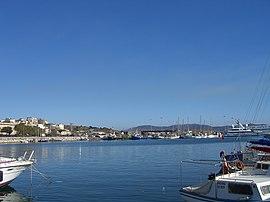Lavrio
Lavrion Laurium Λαύριο/Λαύριον | |
|---|---|
Settlement | |
 The port of Lavrio | |
Location of the Lavreotiki municipal unit | |
| Coordinates: 37°42′N 24°3′E / 37.700°N 24.050°E | |
| Country | Greece |
| Administrative region | Attica |
| Regional unit | East Attica |
| Municipality | Lavreotiki |
| Municipal unit | Lavreotiki |
| Elevation | 10 m (30 ft) |
| Population (2021)[1] | |
| • Total | 7,525 |
| Time zone | UTC+2 (EET) |
| • Summer (DST) | UTC+3 (EEST) |
| Postal code | 195 xx |
Lavrio, Lavrion or Laurium (Greek: Λαύριο; Ancient Greek: Λαύρειον (later Λαύριον);[2] from Middle Ages until 1908: Εργαστήρια Ergastiria)[3] is a town in southeastern part of Attica, Greece. It is part of Athens metropolitan area and the seat of the municipality of Lavreotiki.[4][5][6] Laurium was famous in Classical antiquity for its silver mines, which was one of the chief sources of revenue of the Athenian state. The metallic silver was mainly used for coinage. The Archaeological Museum of Lavrion shows much of the story of these mines.
It is located about 60 km SE of Athens city center, SE of Keratea and N of Cape Sounio. Laurium is situated on a bay overlooking the island of Makronisos (ancient times: Helena) in the east. The port is in the middle and gridded streets cover the residential area of Lavrio. GR-89 runs through Lavrio and ends south in Sounio.
- ^ "Αποτελέσματα Απογραφής Πληθυσμού - Κατοικιών 2021, Μόνιμος Πληθυσμός κατά οικισμό" [Results of the 2021 Population - Housing Census, Permanent population by settlement] (in Greek). Hellenic Statistical Authority. 29 March 2024.
- ^ Liddell, Scott, Jones, Greek Lexicon.
- ^ "EETAA local government changes". eetaa.gr. Retrieved 26 June 2020.
- ^ "ΦΕΚ B 1292/2010, Kallikratis reform municipalities" (in Greek). Government Gazette.
- ^ NWC. "Map of Athens: offline map and detailed map of Athens city". athensmap360.com. Retrieved 2022-01-07.
- ^ "Athens Population 2021 (Demographics, Maps, Graphs)". worldpopulationreview.com. Retrieved 2022-01-07.

